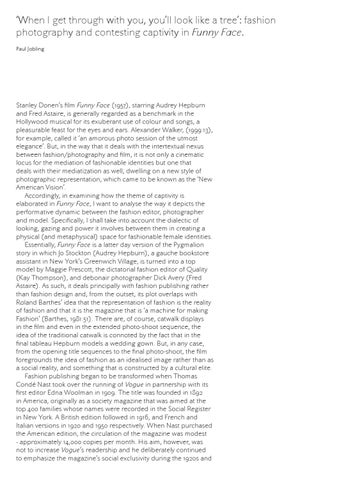‘When I get through with you, you’ll look like a tree’: fashion photography and contesting captivity in Funny Face. Paul Jobling
Stanley Donen’s film Funny Face (1957), starring Audrey Hepburn and Fred Astaire, is generally regarded as a benchmark in the Hollywood musical for its exuberant use of colour and songs, a pleasurable feast for the eyes and ears. Alexander Walker, (1999:13), for example, called it ‘an amorous photo session of the utmost elegance’. But, in the way that it deals with the intertextual nexus between fashion/photography and film, it is not only a cinematic locus for the mediation of fashionable identities but one that deals with their mediatization as well, dwelling on a new style of photographic representation, which came to be known as the ‘New American Vision’. Accordingly, in examining how the theme of captivity is elaborated in Funny Face, I want to analyse the way it depicts the performative dynamic between the fashion editor, photographer and model. Specifically, I shall take into account the dialectic of looking, gazing and power it involves between them in creating a physical (and metaphysical) space for fashionable female identities. Essentially, Funny Face is a latter day version of the Pygmalion story in which Jo Stockton (Audrey Hepburn), a gauche bookstore assistant in New York’s Greenwich Village, is turned into a top model by Maggie Prescott, the dictatorial fashion editor of Quality (Kay Thompson), and debonair photographer Dick Avery (Fred Astaire). As such, it deals principally with fashion publishing rather than fashion design and, from the outset, its plot overlaps with Roland Barthes’ idea that the representation of fashion is the reality of fashion and that it is the magazine that is ‘a machine for making Fashion’ (Barthes, 1981:51). There are, of course, catwalk displays in the film and even in the extended photo-shoot sequence, the idea of the traditional catwalk is connoted by the fact that in the final tableau Hepburn models a wedding gown. But, in any case, from the opening title sequences to the final photo-shoot, the film foregrounds the idea of fashion as an idealised image rather than as a social reality, and something that is constructed by a cultural elite. Fashion publishing began to be transformed when Thomas Condé Nast took over the running of Vogue in partnership with its first editor Edna Woolman in 1909. The title was founded in 1892 in America, originally as a society magazine that was aimed at the top 400 families whose names were recorded in the Social Register in New York. A British edition followed in 1916, and French and Italian versions in 1920 and 1950 respectively. When Nast purchased the American edition, the circulation of the magazine was modest - approximately 14,000 copies per month. His aim, however, was not to increase Vogue’s readership and he deliberately continued to emphasize the magazine’s social exclusivity during the 1920s and
